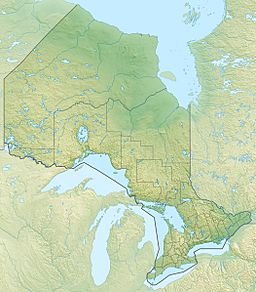Gibson Lake (Pukaskwa National Park) facts for kids
Quick facts for kids Gibson Lake |
|
|---|---|
| Location | Thunder Bay District & Algoma District, Ontario |
| Coordinates | 48°20′23″N 85°19′59″W / 48.33972°N 85.33306°W |
| Type | Lake |
| Part of | Great Lakes Basin |
| Primary outflows | Pukaskwa River |
| Basin countries | Canada |
| Max. length | 2.2 kilometres (1.4 mi) |
| Max. width | 1.2 kilometres (0.7 mi) |
| Surface elevation | 464 metres (1,522 ft) |
Gibson Lake is a beautiful lake located in Northern Ontario, Canada. It stretches across two different areas: the Thunder Bay District and the Algoma District. This lake is special because it's completely inside Pukaskwa National Park, a protected natural area.
Contents
About Gibson Lake
Gibson Lake is an important part of the Great Lakes Basin. This means that the water from Gibson Lake eventually flows into the Great Lakes, which are some of the largest freshwater lakes in the world. The lake is also the starting point for a river called the Pukaskwa River.
Where is Gibson Lake?
Gibson Lake is found in the northern part of Ontario, Canada. It's located in a wild and natural area. The lake is split between the Thunder Bay District and the Algoma District, specifically within Charbonneau Township. Its exact location helps scientists study the environment.
Water Flow and Connections
Water constantly moves in and out of Gibson Lake. Three small, unnamed streams flow into the lake. These streams bring fresh water from the surrounding land. The main river that flows out of Gibson Lake is the Pukaskwa River. This river travels south from the lake. Eventually, the Pukaskwa River empties into Lake Superior, which is the largest of the Great Lakes. This connection shows how all water systems are linked together.
Inside Pukaskwa National Park
One of the most interesting facts about Gibson Lake is that it lies entirely within Pukaskwa National Park. National parks are special places protected by the government. They help keep nature safe for animals, plants, and people to enjoy. Being inside a national park means Gibson Lake's environment is well-preserved. It's a great spot for wildlife to thrive.


